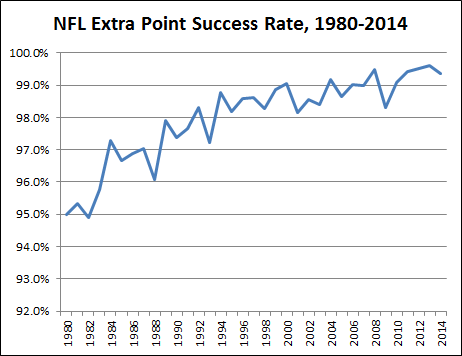Last week, the NFL announced a change to the extra point rules, bringing all the excitement the extra point provided in 1993 to us in 2015. What do I mean by that? Over the last decade, teams have converted over 99% of extra point attempts, and as far back as the late '90s, the league-wide success rate was about 98%. The last season where teams converted "only" 97% of extra point attempts was 1993:

You've probably heard by now that all extra points will now be attempted from the 15-yard line (two-point conversion attempts will remain at the two-yard line). From a practical standpoint, what does this mean? Probably not much: consider that in each of the last two seasons, teams converted 96% of field goal attempts of 31, 32, or 33 yards, approximately where all extra points will now be attempted. And even that ratio might be understimating things: according to Nathan Jahnke, over that same period, kickers were successful 97.6% of the time when kicking from the center of the field (as opposed to on either hash mark) from a distance of 30-35 yards.
Last preseason, the NFL experimented with extra point attempts from the 15-yard line, and the success rate was 94.3%. But remember that such an average includes kickers who did not make final rosters. If we assume that kickers will benefit from months of practice on these kicks, and based on the other data available, I think the best projection we can make as to the success rate of extra points this year is somewhere just north of 97%. Which would make extra points roughly similar to the value proposition they were during the 1993 season.
What does that mean in practical terms? Instead of there being one missed extra point every 2-3 weeks, there will be about two missed extra points per week. For fantasy owners, that means you might wind up losing a point a couple of times during your regular season, but, of course, you are just as likely to benefit from your opponent missing out on that point, too. In general, kickers are often an afterthought in many fantasy leagues; this rule is not going to change that, although it will make the best kickers (and kickers who play in friendly conditions) imperceptibly more valuable than before.
If you happen to be an NFL head coach, this rule might cause you to lose some sleep at night because just about everything causes NFL head coaches to lose sleep. But if you're a fantasy player, don't sweat this one: you're just as likely to benefit from a fluky missed extra point as you are to be burned by one. For fantasy purposes, the NFL just turned the clock back to 1993. That is, of course, with one exception, made possible by a rule change the following year: the advent of the 2-point conversion.
I don't think moving the PAT back 13 yards is going to do much to influence team behavior. But it's always possible (and yes, I'm looking at you, Chip Kelly) that a team decides that going for two should be the default choice after a touchdown. If that happens, that team's kicker obviously becomes much less valuable, and the team's quarterback and running back could wind up getting some bonus points every week. On Tuesday, Mark Kaboly reported that the Steelers, during the team's first drill during OTAs, began by 2-point conversions. It's too early to predict that any team will start going for two as a matter of course, but it's something to keep our eyes and ears on over the next few months.
